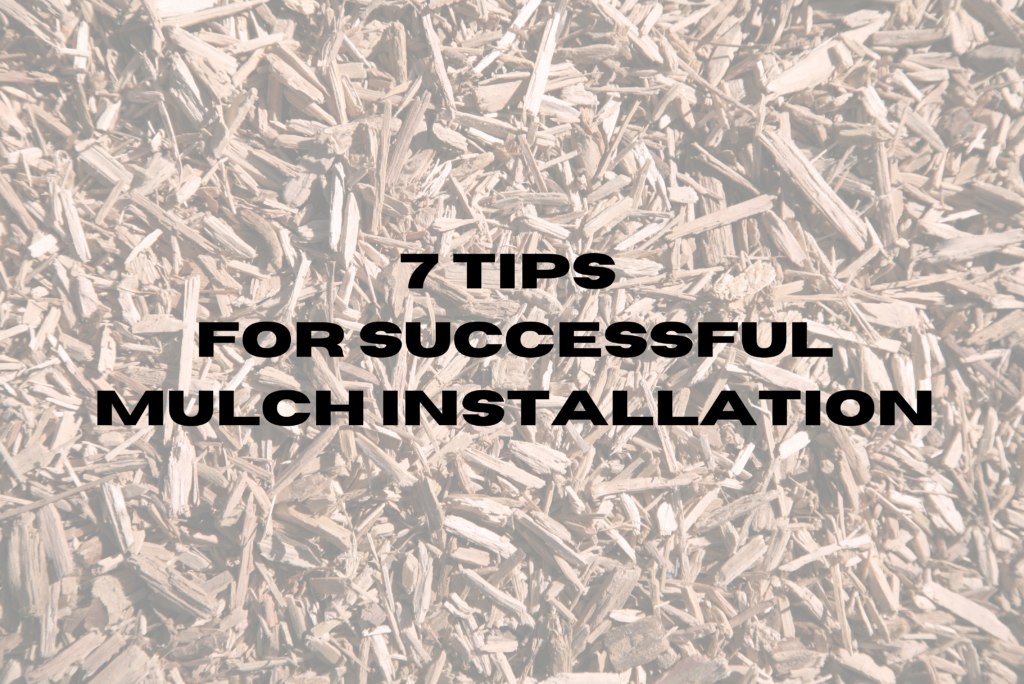Table of Contents
Mulch is a valuable addition to any garden, offering benefits such as weed suppression, moisture retention, and soil improvement. However, achieving successful mulch installation requires proper planning and execution. In this blog post, we’ll explore 7 essential tips to help you achieve optimal results when installing mulch in your garden.
1) Choose the Right Mulch
The first step to successful mulch installation is selecting the right type of mulch for your garden’s specific needs. Organic mulches, such as wood chips, shredded leaves, or compost, are ideal for improving soil quality and promoting microbial activity. Inorganic mulches like gravel or rock are excellent for weed suppression and moisture retention in areas where aesthetics are less of a concern. However, gravel or rock around your home could lead to some problems. If you’d like to explore what these problems are and how to best solve them, read our blog 3 Reasons to Remove Rock and Install Mulch.
2) Prepare the Area
Before applying mulch, prepare the area by removing weeds, debris, and any existing mulch. Level the ground to ensure uniform coverage and good drainage. If necessary, amend the soil with compost or organic matter to enhance its fertility and structure before mulching. Weeds can compete with your plants for nutrients and water, while debris and old mulch can create uneven surfaces that hinder proper mulch distribution. This step not only improves the aesthetics of your garden but also sets the stage for healthier plant growth.

3) Apply the Correct Depth
Proper mulch depth is essential for its effectiveness. Apply mulch at a depth of 2-3 inches, ensuring even coverage across the entire area. Avoid the common mistake of piling mulch against plant stems or tree trunks, as this can create a moisture barrier that encourages rot or pest infestations. By maintaining a proper mulch depth and keeping it away from plant bases, you promote healthier root systems and reduce the risk of detrimental effects on your plants.
4) Maintain a Gap Around Plants
Leave a gap of a few inches around the base of plants, shrubs, and trees when mulching. This prevents mulch from directly contacting stems, which can lead to moisture-related problems such as stem rot and pest infestations. Additionally, a well-maintained gap facilitates proper air circulation around the plant’s base, reducing the risk of fungal diseases like root rot or crown rot. Adequate airflow helps maintain a healthy balance of oxygen and prevents moisture buildup, creating an environment that promotes robust plant growth and resilience against common garden ailments.

5) Mulch Around Trees
Extend mulch out to the tree’s drip line, which is the outermost reach of the branches. Mulching this area effectively protects the tree’s root system by providing insulation, conserves moisture by reducing evaporation from the soil, and minimizes competition from weeds. This extended mulch zone creates an environment conducive to healthy root development and overall tree vitality.
6) Water Before Mulching
Water the area thoroughly before applying mulch to ensure the soil is adequately moist. Mulching on dry soil can lead to moisture loss and hinder the effectiveness of the mulch in retaining water. By pre-watering the soil, you create an ideal environment for mulch installation, ensuring that the mulch can effectively trap moisture and provide a consistent source of hydration for your plants. Proper soil moisture sets the stage from healthy plant growth, root development, and optimal mulch performance throughout the growing season.

7) Monitor Moisture Levels
Regularly check soil moisture under the mulch and adjust watering as needed to maintain optimal conditions for plant growth. While mulch helps retain moisture, it’s essential to ensure plants receive adequate hydration, especially during hot and dry periods. Use a moisture meter or simply dig a small hole beneath the mulch to assess soil moisture levels. If the soil feels dry, water the area thoroughly. However, be cautious about overwatering, as this can lead to root rot, and other moisture-related issues. Strike a balance by providing enough water to keep the soil consistently moist but not waterlogged.
By following these essential tips, you can achieve successful mulch installation that enhances your garden’s health, appearance, and productivity. Whether you’re mulching flower beds, vegetable gardens, or landscape areas, proper mulch application plays a significant role in creating a thriving and beautiful outdoor space! Contact His Workmanship for support on your next mulch project. Watch the video below to hear from a worker who has completed many mulch installation projects.



